The vocoder is an effect mostly used with human voice. First heard in electronic music and has long since established itself in rock and pop music. We look at the development, functionality, current models and provide a few music examples for you to understand the main question: what’s a Vocoder?!
Vocoder – The origins
The vocoder, like many everyday objects, was originally developed for military purposes. The aim was to transmit speech electronically in encrypted form and at a lower data rate, which also explains the name, which is a combination of the English terms “voice” and “encoder”. In a very simplified way, an audio signal was divided into frequency bands whose values were sent as a parameter set. This saved a large amount of data, because the actual voice was not sent.
At the other end, everything was then re-synthesized by creating a speech signal again from a noise signal as a voice substitute through the parameters. An attempt was made to mimic the human speech organ with vocal cords (noise) and tongue and lips (parameters). This was not as good as today’s encryption techniques and compression algorithms, but the vocoder was developed between 1936 and 1939.
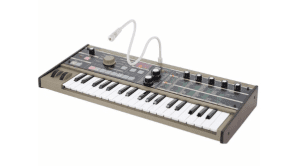
After the first attempts in electronic music during the 50s made by Werner Meyer-Eppler, the head of the phonetics department at the University of Bonn, the first vocoder to be used in a musical context was born: the Siemens synthesizer, developed in Munich. And since Bob Moog and Wendy Carlos developed and used a vocoder for the soundtrack of the movie “Clockwork Orange” in 1971, there was a real push for further development of this new instrument. By the end of the 1970s at the latest, the vocoder had arrived in popular music thanks to bands like Kraftwerk, Pink Floyd and Electric Light Orchestra. Between 1976 and 1979 models like the EMS Studio Vocoder, Korg MS-10 or the Roland VP-330 were introduced in the market.
You are currently viewing a placeholder content from YouTube. To access the actual content, click the button below. Please note that doing so will share data with third-party providers.
Vocoder – How it’s used in music
The basic principle of a vocoder in music is basically the same as the original version: there is a carrier signal whose level is modulated by a second signal. However, instead of noise, a freely selectable carrier signal is now usually used, which is influenced by the modulation signal. Many vocoders have their own sound generation for this purpose, but this is not absolutely necessary if an external input for the carrier signal is available. The modulation signal is now also divided into different frequency bands by bandpass filters. In the individual frequency bands, envelope followers then analyze the volume curve and transfer it to the carrier signal accordingly. Thus the carrier is what comes out of the vocoder as sound, and the modulation signal influences how the carrier is heard.
Any continuous signal with as many harmonics as possible is suitable as a carrier. This ensures that the modulations by the second signal also has an appropriate effect. And of course the carrier signal may also be a melody or polyphonic chords, so that the finished vocoder signal starts to… sing!
You are currently viewing a placeholder content from YouTube. To access the actual content, click the button below. Please note that doing so will share data with third-party providers.
The human voice is often used as modulation signal, which is obvious due to its origin and to the presence of a microphone, often already present in vocoders. Having said that, the use of human voice is by no means mandatory! To achieve interesting and unique results, actually any signal that clearly “moves” the carrier signal works, i.e. also drums, percussion or other signals with fast attack phases and clear level differences that cause corresponding jumps in the carrier signal.
Vocoder – Hardware and Software
Vocoder sounds appear again and again throughout contemporary music history, and are now an indispensable element in music. Between technologically ambitious modern proposals to reissues and replicas of the classics, there are many Vocoder-related instruments to choose from for your next musical endeavour.
Korg microKorg
The Korg microKorg is not only the longest continuously built synthesizer in history, but also houses a great sounding descendant of the aforementioned Korg VC-10. The gooseneck microphone is not included by accident!

Behringer Vocoder VC340
It is by no coincidence that this analog vocoder with integrated string ensemble synthesizer resembles the previously mentioned VP-330, as in fact, it is a clone very close to the original. And it’s also much cheaper!
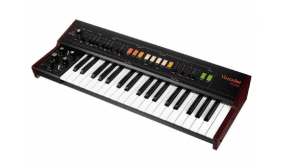
Arturia MicroFreak
This small hybrid synthesizer with touch keyboard now also contains a full-blown vocoder. Just plug in the microphone and start recording! A gooseneck microphone is available as an accessory (for a small price) at this link.
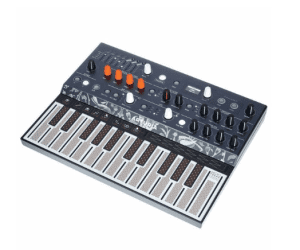
Rob Papen RoCoder
There are also great software vocoders that make use of the advantages of a computer-based effect. For example, this 32-band vocoder by Rob Papen has many additional functions and possibilities that invite you to experiment and generate the wildest sound you could think of.
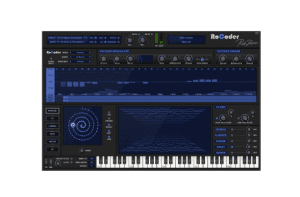
Vocoder – classic and modern examples in Music
Kraftwerk – Die Stimme der Energie
Everyone knows “Autobahn”. What’s even more memorable is this track from the album “Radioaktivität”, which has been sampled dozens of times.
You are currently viewing a placeholder content from YouTube. To access the actual content, click the button below. Please note that doing so will share data with third-party providers.
Pink Floyd – Sheep
This song from the 1977 album “Animals” is not exactly short at 10:18 min. The vocoder kicks in from 6:24 min. and shows the joy of experimentation for which the legendary British band was so popular.
You are currently viewing a placeholder content from YouTube. To access the actual content, click the button below. Please note that doing so will share data with third-party providers.
Electric Light Orchestra – Mr. Blue Sky
ELO have set a musical monument to the vocoder with the album “The Vocoder“. On “Mr. Blue Sky” from this album the popular effect starts at 2:38 min. Have fun!
You are currently viewing a placeholder content from YouTube. To access the actual content, click the button below. Please note that doing so will share data with third-party providers.
Zedd, Maren Morris, Grey – The Middle
After so many oldies, here’s proof that the vocoder is still being used in current pop music. Producer Zedd uses it to accompany the entire chorus. And it sounds great!
You are currently viewing a placeholder content from YouTube. To access the actual content, click the button below. Please note that doing so will share data with third-party providers.
Quiz time
Did you learn something after reading this article? Find out by taking our quiz!
You are currently viewing a placeholder content from Riddle. To access the actual content, click the button below. Please note that doing so will share data with third-party providers.
Do you use a vocoder yourself or do you have a favorite song featuring this effect? Let us know with a comment!








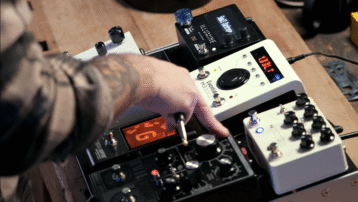







Comments 1